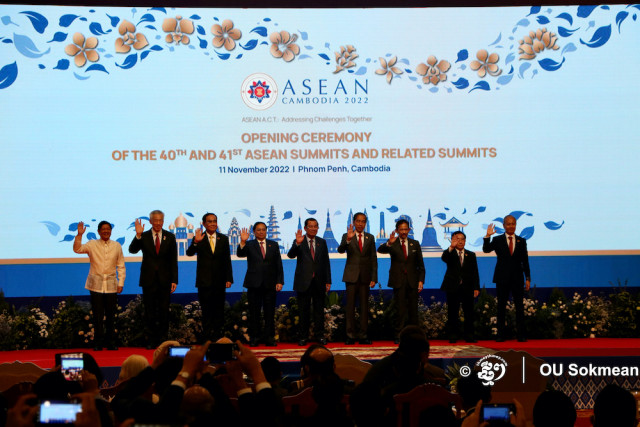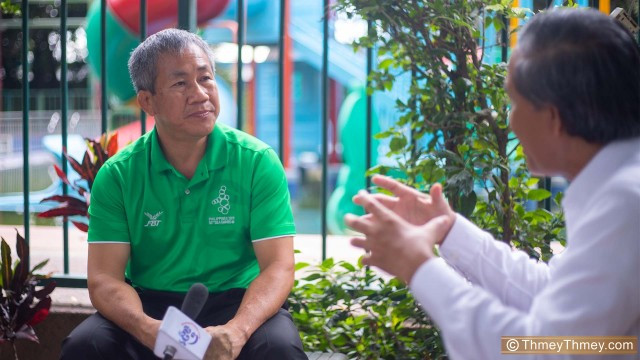Opinion: Taiwan Strait Tensions Cause ASEAN Rift

- By Sokvy Rim
- November 11, 2022 4:04 PM
US House of Representatives Speaker Nancy Pelosi visited Taiwan on Aug. 2, a day before ASEAN foreign ministers met in Phnom Penh. The visit led to rising tension in the Taiwan Strait and conflicting responses from ASEAN states.
The approaches to Taiwan of the US and China are showing signs of more intense rivalry. This is marked by the US shifting from “strategic ambiguity” to “strategic clarity” and China showing sign of impatience to unify Taiwan by peaceful means.
Examples are the recent reinforcement of the US engagement with Taiwan and China expressing a tougher stance on the island. In 2022, the US State Department approved arms sales of $1.1 billion to Taiwan. Chinese recently released a white paper titled “The Taiwan Question and China’s Reunification in the New Era” which says China cannot be secure if Taiwan remains separate from the mainland.
Dealing with this situation, ASEAN should consider putting Taiwan’s situation on its agenda for the ASEAN summit which is happening now in Phnom Penh.
The US and China both have significant economic and political ties to Southeast Asia. China is ASEAN’s largest trading partner and giant neighbor while the US is the largest source of foreign direct investment and plays a key security role in the region. ASEAN member states cannot risk alienating themselves from these superpowers. For this reason, the foreign policies of Southeast Asian countries have been characterized by neutrality, non-interference and non-alignment between the US and China.
The most clear-cut example would be Vietnam. With the security concern in the South China Sea, Vietnam is supposed to move toward the US, however, Vietnam prefers to opt not to take sides as moving closer to the US, particularly on the issue of the South China Sea, can affect Vietnam economic growth due to its close economic relations with China.
Cambodia also depends on both the US and China. China is Cambodia’s largest source of foreign direct investment (FDI) while the US is its largest export market.
For example, In 2021, Cambodia received $2.32 billion of FID from China and $163 million from the US. However in the same year, Cambodia exported to the US around $6 billion while exporting to China only around $1.51 billion.
Similarly, Thailand, which is a US key ally, also has very close economic relations with China. Vietnam, Cambodia and Thailand’s positions are shared by most states in the region.
Efforts to remain steadfastly neutral
Before Pelosi’s visit, some ASEAN states tried to maintain their neutral foreign policy. Vietnam, for instance, has maintained its “four-noes” policy of no military alliance, no building an alliance to counter other countries, no foreign military base and no threatening to use force in international relations.
In August of 2021, the US Vice President Kamala Harris visited Vietnam, in which she reiterated the US
Cambodia as well has been trying to strike a balance between the superpowers. During the World Economic Forum in Switzerland in May 2022, for instance, Prime Minister Hun Sen stressed Cambodia’s commitment to a neutral foreign policy.
He said, “I also noticed that our friends, who are superpowers, told us that there is no need to choose between them, and we also confirmed that if those countries let us choose, we will not.”
Reading between the lines reveals more
However, when it came to Pelosi’s Taiwan trip, a few ASEAN countries appeared to subtly take sides. The responses from top government officials and statements from foreign ministries can be understood as being indirectly sympathetic to one side or the other. The states sympathetic to China’s position spoke out to condemn the visit and spoke out specifically on behalf of respect for sovereignty and territorial integrity of other nations. The states whose positions more closely aligned with the US were more likely to call for restraint and to solve the issue by peaceful means.
Singapore, Vietnam, the Philippines and Indonesia appeared to echo the US and its allies’ calls which urged China to cease its military drills around Taiwan and to avoid rising tensions.
Singapore
Similarly, Vietnam said it “wishes for all relevant parties to restrain themselves, not escalate tension in the Taiwan Strait, positively contribute to the maintenance of peace and stability, and strengthen cooperation and development in the region and the world.” The statement could be interpreted as indirectly criticizing China, without mentioning respect for sovereignty.
The Philippines Foreign Affairs Ministry expressed a desire to avoid "any miscalculation and further escalation of tensions." And Indonesia called on "all parties to refrain from provocative actions that may worsen the situation."
Other ASEAN member countries chose to criticize the actions of Pelosi and of the US. Myanmar along with Cambodia and Lao appeared to be supportive of China’s position while indirectly criticizing the US for interfering in China’s internal affairs.
Myanmar’s military-led government went so far as to directly criticize the US saying Pelosi’s visit was escalating tensions in the Taiwan Strait.” It said, “Myanmar opposes any provocative actions causing instabilities in the region and attempt to interfere in the internal affairs of other states.”
Similarly, during the ASEAN foreign ministers meeting in Phnom Penh, Cambodia Foreign Minister Prak Sokhonn told his counterpart, Chinese Foreign Minister Wang Yi, that “the recent US provocations violated China’s sovereignty, broke its own promise and aggravated cross-Strait tensions, fully exposing the hypocrisy and hegemonic behavior of the US side.”
Laos also condemned the rising of tension. But instead of calling for peace, the Laos government “reiterate[d] its support for the policy of the Government of the People’s Republic of China on the national unification by peaceful means.”
Taking this into consideration, Pelosi’s Taiwan visit has exposed the division within ASEAN, and it will continue to widen as the rivalry between the US and China continues to grow. The current trend of the US and China is becoming more dangerous than ever and could produce unbearable consequences for ASEAN states.
Against this backdrop, ASEAN, as an institutional hub for cooperation in the region, should engage with both superpowers for dialogue in the ASEAN summit in Phnom Penh. This measure will, to some extent, help build trust and avoid any miscalculation that can lead to unnecessary military confrontation in the region.
Failing to cope with tension in its early phase can produce unintentional consequence that can bring unbearable damage to ASEAN, particularly its economic and security.
Sokvy Rim is a junior research fellow at the Future Forum, an independent Cambodia-based public policy think tank.















